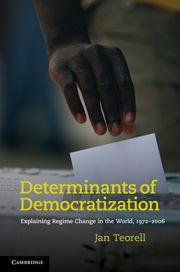Book contents
- Frontmatter
- Contents
- List of tables
- List of figures
- Acknowledgments
- Introduction
- 1 Explaining democratization
- 2 The shadow of the past: social determinants
- 3 The power of prosperity: economic determinants
- 4 The impetus from abroad: international determinants
- 5 The force from below: popular mobilization
- 6 Exogenous shocks and authoritarian regime types: institutional contingency
- 7 Conclusions
- Appendix A Data and variable definitions
- Appendix B Statistical model
- Appendix C Robustness tests
- Appendix D The pathway criterion
- References
- Index
5 - The force from below: popular mobilization
Published online by Cambridge University Press: 05 June 2012
- Frontmatter
- Contents
- List of tables
- List of figures
- Acknowledgments
- Introduction
- 1 Explaining democratization
- 2 The shadow of the past: social determinants
- 3 The power of prosperity: economic determinants
- 4 The impetus from abroad: international determinants
- 5 The force from below: popular mobilization
- 6 Exogenous shocks and authoritarian regime types: institutional contingency
- 7 Conclusions
- Appendix A Data and variable definitions
- Appendix B Statistical model
- Appendix C Robustness tests
- Appendix D The pathway criterion
- References
- Index
Summary
Democratization never just happens. Someone has to take action to install, or protect, democratic institutions. In the most immediate sense these actions are usually taken by political elites: that is, by key decision makers in the governmental organizations of the state. It has often been noted, however, that another forceful actor, the populace or “demos” itself, sometimes enters the scene, pushing for or resisting reforms. To what extent did this force from below affect the third wave of democratization? In this chapter I first review the literature and empirical evidence to this effect, and then, in order to uncover the causal mechanisms at work, I turn to case studies of three critical incidences of democratization wrought through peaceful demonstrations.
The literature and empirical results
In the founding texts of the strategic approach, as noted in Chapter 1, democracy appeared to have been brought about in the context of demobilized masses (O’Donnell and Schmitter 1986). This view, which was primarily based on experiences from Southern Europe and Latin America, was, however, challenged empirically in later accounts of the same world regions (Bermeo 1997; Collier 1999). Moreover, the contrast seems even sharper in relation to the subsequent collapse of authoritarian regimes in Asia, Eastern Europe and Sub-Saharan Africa. In these instances collective action undertaken by the mass public appears to have been a widely occurring phenomenon, with alleged democracy-enhancing effects (Bratton and van de Walle 1997, pp. 83–4; Geddes 1999, p. 120; McFaul 2002, pp. 222–23; Bunce 2003, pp. 171–78; Schock 2005). Evidence from the “colored revolutions” in Eastern Europe and Central Asia points in the same direction (Beissinger 2007; Tucker 2007). Anecdotal evidence also suggests that democratization in both Western Europe and Latin America in the early twentieth century followed in the wake of social unrest and popular mass action (Acemoglu and Robinson 2006, pp. 67–68, 71–73; also, see Tilly 2004).
Information
- Type
- Chapter
- Information
- Determinants of DemocratizationExplaining Regime Change in the World, 1972–2006, pp. 100 - 116Publisher: Cambridge University PressPrint publication year: 2010
